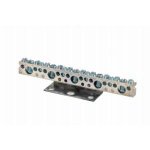petersonra
Senior Member
- Location
- Northern illinois
- Occupation
- Semi-retired engineer
It seems a long standing practice for industrial control panel manufacturers to put a piece of copper bar in to use as a ground bar that is typically just bolted to the sheet iron.
This has gotten to be an expensive thing to do with the cost of copper being what it is these days. That and the cost of drilling and tapping the bar for the lugs and the mounting.
Other than tradition, is there any real downside to just connecting the ground wires with lugs direct to the sheet iron?
Another practice that seems common that I just don't get is the practice of running a large gage wire from the ground bar to a lug near the disconnecting means? The conductivity of the sheet iron is far less than that of the wire so what benefit is there? Again, other than tradition.
This has gotten to be an expensive thing to do with the cost of copper being what it is these days. That and the cost of drilling and tapping the bar for the lugs and the mounting.
Other than tradition, is there any real downside to just connecting the ground wires with lugs direct to the sheet iron?
Another practice that seems common that I just don't get is the practice of running a large gage wire from the ground bar to a lug near the disconnecting means? The conductivity of the sheet iron is far less than that of the wire so what benefit is there? Again, other than tradition.


